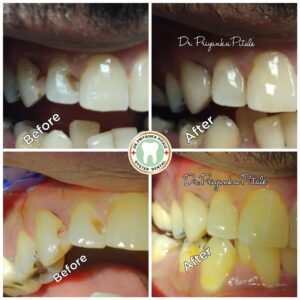
Dental Fillings
Dental fillings are a common and essential procedure in dentistry, used to restore the integrity, function, and morphology of missing tooth structures that result from cavities or external trauma. Fillings play a crucial role in maintaining oral health by preventing the progression of tooth decay and preserving the tooth’s structure.
Every time the tooth structure is lost either by trauma or cavities or due to wear and tear, it has to be replaced to achieve normal function and aesthetics in order to avoid sensitivity and infection in the root canals.
Nowadays, various filling materials are available, which include Silver Amalgam, Composite, GIC, few temporary and intermediate temporary fillings.
Some fillings are time-tested, some are aesthetic, some have medicated properties, while some adhere to the tooth structures naturally.
Here at Oyster Dental, we have “Ivoclar NG4 Blue Phase” as the world’s number one light cure unit and “Tokuyama’s Palifique” as the world’s best composite filling material.
We also have “Style Italiano Composite Instruments” specifically crafted to achieve superior esthetics for front teeth fillings.
Types of Dental Fillings
There are several types of dental fillings, each with its own unique properties and suitability for different dental needs:
1. Amalgam Fillings: Made from a mixture of metals including silver, mercury, tin, and copper, amalgam fillings are known for their durability and strength. They are typically used in molars, where the forces of chewing are greatest. Although amalgam fillings are cost-effective and long-lasting, their metallic color makes them less aesthetically pleasing compared to other options.
2. Composite Fillings: Composed of a mixture of plastic and fine glass particles, composite fillings are popular for their natural appearance. They can be closely matched to the color of the patient’s teeth, making them an excellent choice for visible areas. Composite fillings bond directly to the tooth structure, providing additional support, and are less invasive than amalgam fillings. However, they may not be as durable for large restorations or areas subjected to heavy chewing forces.
3. Ceramic Fillings: Made of porcelain, ceramic fillings are highly durable and resistant to staining. They offer excellent aesthetics and can be used for both anterior and posterior teeth. Ceramic fillings are more expensive than composite or amalgam fillings and typically require at least two dental visits for placement since they are custom-made in a dental laboratory.
4. Glass Ionomer Fillings: Comprising a mix of acrylic and a specific type of glass, these fillings release fluoride, which helps protect the tooth from further decay. Glass ionomer fillings are usually used for fillings below the gum line and in areas not subjected to heavy chewing. While they are not as strong or durable as other types, their ability to release fluoride makes them beneficial for children’s teeth and those prone to decay.
The Dental Filling Procedure
The procedure for placing a dental filling involves several steps:
1. Diagnosis: The dentist identifies the extent of the decay using visual examination, dental instruments, and X-rays.
2. Anesthesia: Local anesthesia is administered to numb the area around the affected tooth, ensuring the patient experiences minimal discomfort.
3. Decay Removal: The dentist uses a drill, laser, or air abrasion instrument to remove the decayed portion of the tooth.
4. Cleaning: The cavity is thoroughly cleaned to remove any bacteria or debris.
5. Filling Placement: The chosen filling material is placed in the cavity, shaped, and hardened using a special curing light (for composite fillings). The dentist then polishes the filling to ensure a smooth surface that fits seamlessly with the surrounding tooth structure.
Benefits and Considerations
Dental fillings are essential in preventing further decay, restoring tooth function, and maintaining oral health. They help preserve the natural tooth structure, preventing the need for more extensive treatments like crowns or root canals. Proper oral hygiene and regular dental checkups are crucial to ensuring the longevity of fillings and overall dental health.
In conclusion, dental fillings are a vital aspect of dental care, offering various materials and techniques to suit different needs. They play a significant role in restoring and maintaining healthy teeth, ensuring that patients can enjoy a functional and aesthetically pleasing smile.